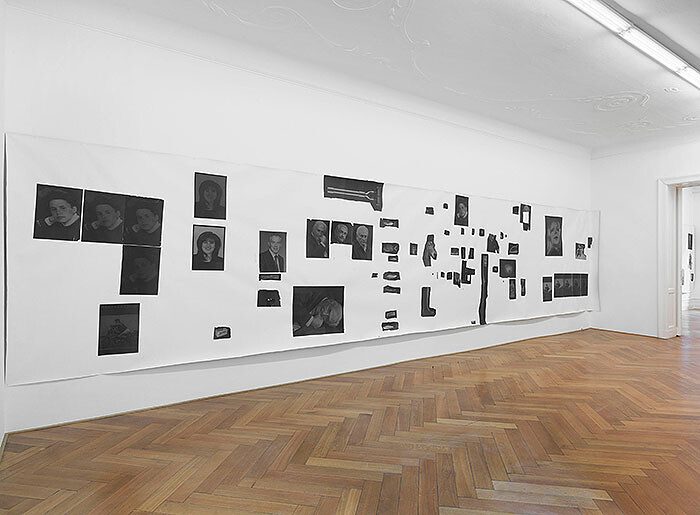The aggressively roughshod aesthetic that characterizes Henrik Olesen’s work clashes immediately with the bourgeois atmosphere of Galerie Buchholz’s bel-étage apartment space: the exhibition press release and checklist have been stuck haphazardly onto the wall in the elegant entrance, while two further texts printed on adhesive transparencies are affixed to the hallway’s decorative mirror. Meanwhile, the doorway to one of the gallery’s main showrooms ahead has been dry-walled shut. On the glass panel of the door leading into a small reception room is one of the texts already encountered before, a list enumerating six different categories of sex, ranging from “AMBIGUOUS SEX” to “PATRIARCHAL SEX.” Further documents are affixed to the room’s other surfaces: excerpts from Robert Walser’s hypnotic 1917 novella The Walk; or the colophon from Polysexuality, a book published by Semiotext(e) in 1981, which seems to be the source of the aforementioned sexual classifications. The list itself appears again, so repeatedly in fact that it becomes a confrontation. Where do we place ourselves on this index of sex? And what about the artist himself?
The stately self-assurance of the gallery’s rooms is undermined by further unkempt details. There are visible nail holes and screw plugs in the walls that seem to have been left behind from the previous exhibition, but are actually new additions which suggest previous uses or occupations of the space. They enact a haunting of sorts, but one so slight that intentionality is hard to determine; we cannot easily locate the artist, nor find our own footing here. On the floor in the corner are six cardboard boxes full of t-shirts printed with black-and-white images and scrawled text, which are free for the taking. Though they are presumably illustrations of the six different types of polysexuality Olesen itemizes above, we remain none the wiser.
Following the path proscribed by Olesen’s rough remodeling of the space, a horizontal drywall creates a narrow corridor that serves to screen the show’s main works (this wall itself is also a work, borrowing its title, Der Spaziergang (2013) from Walser’s original German text). Two long stretches of canvas are nailed to the walls and scattered with black-and-white inkjet print outs of figures well known from politics and media. Here are Tony Blair, Dominique Strauss-Kahn, Popes Benedict and Francis, and Chelsea (formerly known as Bradley) Manning, along with other faces more difficult to place, like Ruby Rubacuori or “Heartstealer” (Silvio Berlusconi’s underage escort friend), or Brandon Teena, the transgender teenager murdered in 1993. Are these the “hysterical men” of the works’ titles? Or are they examples of Olesen’s chosen types of polysexuality (the cover of that book is also included in the collage)?
A more specific clue may be found in the two categories of the artist’s own invention in the list: “MEDIA SEX” and “PATRIARCHAL SEX.” Each of the men or women pictured, even if they themselves are untarnished by sexual scandal, is embroiled in the power games set up by mass media or political patriarchy. Their connection to any grander or more explicit narrative in Olesen’s mind remains opaque, however, especially since they are interspersed with pictures of seemingly unrelated objects—a toothbrush, a potato, a fish, a comb, etc. We find ourselves reading, or misreading, the horizontal span of images, trying to press our knowledge into the service of interpretation. While each element is straightforward and unadorned—simply printed in black and white, cut out, and then fastened onto the canvas—their juxtaposition, at times comic, suggests alternative readings beyond the bare facts, introducing a crisis of interpretation. A work titled Bügeleisen (Steam Iron) (2013) is similarly oblique. How to unpack the meaning of an iron in a cardboard box? Is it the artist’s own iron? Would this artist even own an iron? What do our assumptions about these objects say about societal norms or deviations from them?
Olesen confronts his audience head-on with uncompromising questions about sexual identity, authority, and the machinations of power, but he counteracts this through a strictly controlled strategy of refusal. The conspicuous absence of his own position in relation to everything on view suffuses the exhibition’s carefully staged voids with menacing, undisclosed significance. The assembled fragments do not cohere neatly into a single, simple narrative—even after the gallery assistant provides you with a printed guide identifying each of the faces on the canvas’s collage. In this show, as is the case with many of Olesen’s exhibitions, the printed information we are given is never as informative as it appears. Rather, meaning occurs between the lines or in the interstices between the works; they make us think and move uneasily. If we follow Olesen’s lead through the gallery space, we arrive at doorways that are locked or entirely boarded up—a dead end. Is this the ultimate endgame of patriarchal sexual norms? Polysexuality, however, may open many other doors.











